Garden Office Doors: Making the Right Choice
Table of Contents
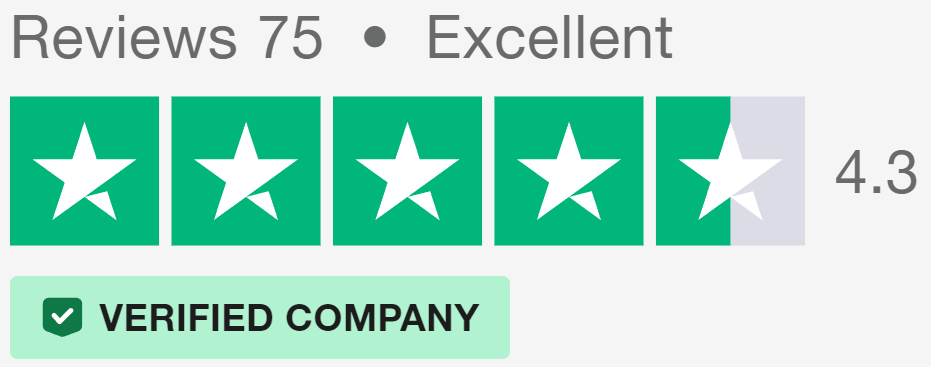
Different Types of Garden Office Doors
Modern garden office doors blend practicality with style, giving you multiple ways to connect your workspace with the outdoors. Each type offers distinct benefits for different garden office layouts and working patterns.
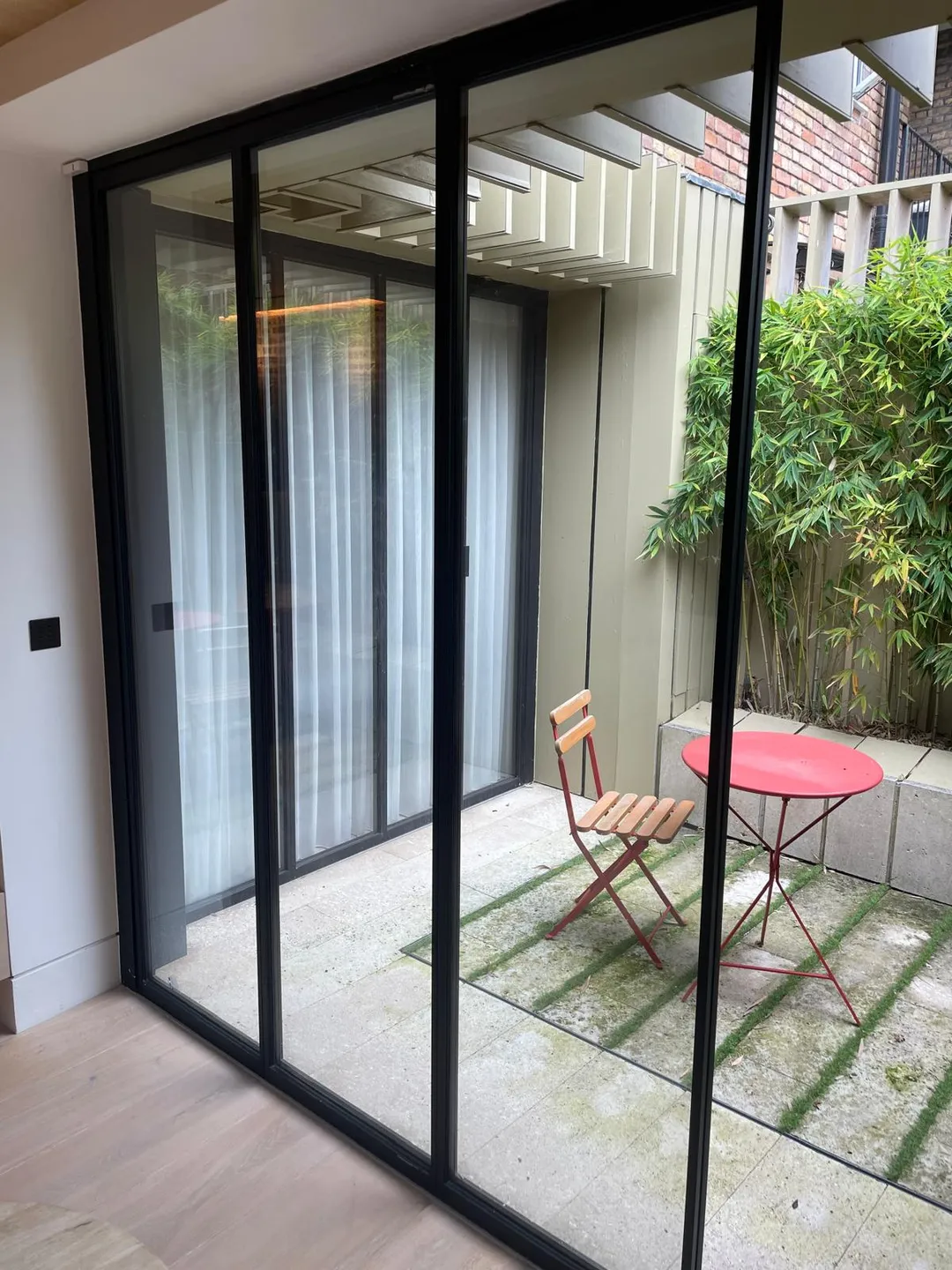
Sliding Glass Systems
Garden office sliding doors suit larger workspaces where you need flexible access throughout the day. Moving smoothly along precision-engineered tracks, these doors stack behind one another to partially or fully open your office front. The lack of swing space makes them particularly practical when you’re arranging furniture or planning desk positions near the doorway.
At their core, sliding systems preserve more usable space than other door types because their panels move parallel to the wall. Double or triple-track designs let you choose exactly how much of the opening you want to reveal, perfect for maintaining temperature control while still enjoying fresh air during your workday.
Bifolding Options for Small Spaces
Garden office bifold doors work brilliantly in compact spaces where traditional swing doors would eat into valuable floor area. Their panels fold neatly against the wall, creating wider openings than sliding systems within the same frame width. The concertina-style movement means you can fully open up your workspace on warm days without losing interior space to door swing.
The pros and cons of bifold doors often centre around their configuration and ease (or difficulty) of use. While they open wider than sliding panels, the folded door stack requires some space at the sides of your opening. This trade-off often proves worthwhile in garden offices under 15 square metres, where making the most of usable floor space takes priority.
Frameless Glass Systems
Doors for garden rooms don’t always need visible frames. Frameless systems use specially toughened glass panels that seem to float in place, creating clear sightlines to your garden workspace. These minimalist designs rely on discrete floor tracks and nearly invisible fixings to support their weight.
The visual impact of frameless garden office glass doors extends beyond pure aesthetics. Without visible frames breaking up your view, you maintain a stronger connection to the surrounding greenery – especially valuable when you’re spending long hours at your desk.
Slide and Stack Systems
Garden office folding doors that pivot and stack offer the best of both sliding and bifold systems. Each panel moves independently along a track before pivoting at the end, creating a neat stack that sits perpendicular to the opening. This mechanism proves particularly useful in garden studio designs where you want to completely open one side of the room.
Space Planning with Stacking Doors
The way panels stack can impact your garden room’s usability. Unlike standard folding doors that create an accordion effect, slide-and-stack systems tuck away more neatly at the sides. This arrangement lets you position desks or shelving closer to the doors without worrying about clearance space, while still maintaining the ability to fully open your office to the garden.
Planning Your Door Layout
Creating a practical layout for garden office doors requires careful thought about how you’ll use the space day-to-day. Each panel configuration brings its own advantages, from mixed arrangements that combine fixed and opening sections to designs that complement specific building shapes.
Mixed Panel Arrangements
Fixed glazing paired with opening sections offers an ideal balance between light, views, and ventilation in garden office doors. Wide glass panels work well as corner pieces or central features, while smaller opening sections provide targeted airflow exactly where you need it. This arrangement proves particularly valuable in garden office projects where desk positions need to stay constant.
Placing operating panels strategically around fixed glass helps manage temperature and fresh air without disrupting your workflow. In south-facing offices, fixed panels with specialised coatings reduce heat gain while opening sections provide quick cooling when needed. North-facing installations often benefit from larger operating sections to capture available sunlight.
The height measurements of each panel type influence the overall visual impact. Fixed panels can stretch from floor to ceiling since they don’t carry mechanical components, creating dramatic sight lines. Operating sections typically require more robust frames to support their movement, though modern systems keep these surprisingly slim.
Door Sizes for Different Builds
Narrow garden offices demand particularly thoughtful door planning. Bifolding doors that stack to one side can open up an entire wall without protruding into the room, while sliding systems might limit your access width. The level of accuracy in measuring becomes especially important in tight spaces – even small discrepancies can affect how doors operate.
Garden office double doors provide a traditional feel while maintaining good access width. They work especially well in smaller builds where full-width glass systems might overwhelm the structure. When paired with side panels, they create an appealing symmetrical look without compromising on natural light.
Structural Factors
Load-bearing calculations play a vital part in door selection. The weight of glass doors for garden offices puts specific demands on the building structure, particularly with wide openings. Steel beams or reinforced lintels often need integration into the design, though these can be concealed within the ceiling space to maintain clean lines.
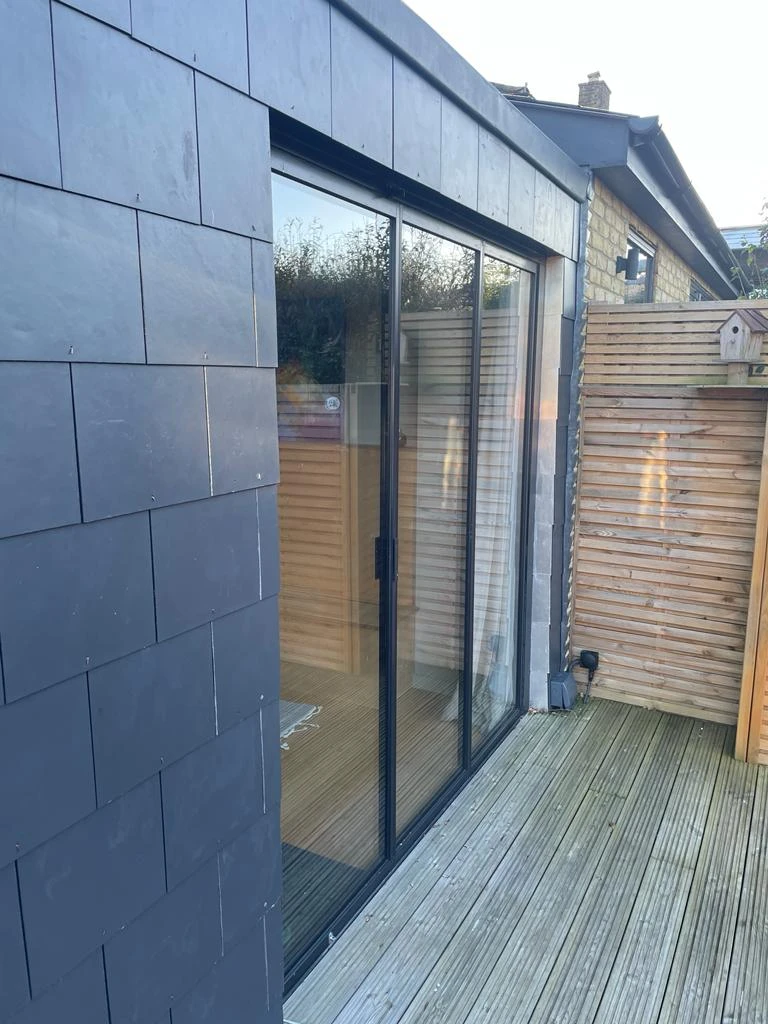
Access Points and Flow
Your door configuration should match your daily routines. Morning sun through east-facing garden office doors might help you start the day energised, while west-facing panels need careful planning to avoid afternoon glare on screens. The relationship between door positions and desk layouts particularly matters when you’re hosting video calls – you’ll want to avoid bright backlighting.
Multiple access points can improve the practicality of larger spaces. A main entrance with wide panels for summer use combines well with a smaller side door for quick access in poor weather. This setup helps manage heating costs while still providing the flexibility to open up the space fully when conditions allow.
Traffic patterns between different areas need careful planning. The swing arc of doors shouldn’t clash with storage units or interfere with colleague movement in shared spaces. Setting operating panels back from corners gives you more freedom with furniture placement while maintaining easy access to all parts of the room.
External Space Integration
The outside area immediately around garden office doors needs just as much planning as the interior. Patios or decking should sit at the right height to prevent trip hazards, while still keeping water out during heavy rain. French drains or subtle channels help manage water runoff without creating obvious breaks in the surface.
Planting schemes can work alongside your door layout to create privacy where needed. Tall grasses or shrubs positioned strategically filter views without blocking light, particularly useful in overlooked gardens. The key lies in balancing screening with the benefits of open sight lines to the garden.
Garden Office Door Materials and Finishes
The materials you choose for garden office doors shape how your workspace looks, feels and performs throughout the year. From frame composition to glass specifications, each element contributes to the comfort and usability of your office.
Glass Options for Work Spaces
Double glazing forms the foundation of comfortable garden offices, providing essential thermal insulation while keeping noise at manageable levels. Modern units incorporate warm-edge spacer bars and argon gas filling to improve their performance, particularly important in exposed locations or near busy roads.
Low-emissivity coatings help garden office glass doors regulate internal temperatures by reflecting heat back into the space during winter while bouncing away excess solar gain in summer. These invisible layers work alongside tinted options to create pleasant working conditions without compromising natural light levels.
Laminated glass adds extra security to your outdoor workspace while cutting down on UV rays that might cause screen glare. The interlayer also reduces noise transmission – useful when you need to focus during video calls or concentrated work periods. Solar control variants can block up to 40% of incoming heat without darkening the glass noticeably.
Advanced Glazing Technology
Recent developments in glass manufacturing have improved the performance of frameless glass doors substantially. Self-cleaning coatings reduce maintenance needs, while advanced interlayers can switch from clear to opaque electronically – perfect for privacy during client meetings in your garden office.
Frame Colours and Materials
External aluminium sliding doors offer superior weather resistance and slim sight lines. The powder-coated finish stands up well to British weather, resisting corrosion even in coastal areas. Textured coatings provide extra durability while hiding minor scratches that might occur during daily use.
UPVC frames suit budget-conscious home office extension projects without compromising on thermal efficiency. Modern profiles feature multiple internal chambers that trap air for improved insulation, though they typically have wider frame sections than aluminium alternatives.
Garden office doors made with thermally-broken aluminium combine strength with excellent insulation. The thermal break – a non-conductive barrier between inner and outer frame sections – prevents cold bridging and reduces condensation risk substantially. This construction method allows for larger glass panels while maintaining good thermal performance.
Hardware Choices
Stainless steel handles and hinges resist corrosion while providing smooth operation year after year. Look for marine-grade options in coastal areas, where salt spray can quickly degrade lesser materials. Multi-point locking systems spread the load evenly across the frame, improving security and preventing warping.
Running gear quality particularly matters in bifold doors, where multiple panels need to move smoothly together. Needle roller bearings reduce friction and wear, while adjustable rollers help maintain optimal panel alignment as buildings naturally settle over time.
Low-profile options reduce trip hazards but might allow more water ingress during driving rain. Rebated designs offer better weather protection at the cost of a small step – worth thinking about if you frequently carry equipment between house and office.
Frame Finishes and Durability
Powder-coated aluminium framed sliding doors often come in hundreds of RAL colours, letting you match or contrast with surrounding garden features. Dual-colour options – different finishes inside and out – help garden office doors harmonise with interior colour schemes while maintaining a cohesive external appearance.
Metallic finishes require careful specification to avoid showing fingerprints excessively. Fine-textured coatings provide a good balance between visual interest and practical maintenance, hiding minor marks while still looking sophisticated. Anodised finishes offer excellent durability but limit your colour options mainly to silvers and bronzes.
Wood-grain effects give UPVC and aluminium frames a natural appearance without the maintenance requirements of timber. Modern foils accurately replicate different species and can include subtle grain textures that feel convincing to touch. These finishes work particularly well when you want your garden office doors to complement existing wooden windows or garden structures.
Light and Space in Garden Office Doors
Natural light profoundly changes how your workspace feels and functions throughout the day. The right glass doors can help create bright, inspiring conditions that improve focus and productivity while reducing artificial lighting needs.
Using Height in Design
Tall garden office doors draw the eye upward, making even modest spaces feel more open and airy. Floor-to-ceiling glazing creates unbroken views of the garden, bringing nature into your daily work environment. When paired with high ceilings, these extended glass panels turn compact offices into light-filled retreats.
Many shed office conversion projects benefit from replacing small windows with full-height glass doors. The increased glazing area transforms dark, cramped spaces into bright workrooms. Even north-facing installations see marked improvements in natural light levels when switching to taller door designs.
Bifold doors with extended height panels need careful balancing to avoid overwhelming smaller spaces. Dark frames can look striking against pale walls but might dominate in compact rooms. Opting for slimmer frames or lighter finishes helps maintain an open feel while still providing contrast.
Structural Integration
Load-bearing requirements change as door heights increase. Garden office glass doors stretching beyond standard dimensions often need additional structural support, though modern frame systems conceal these reinforcements within their profiles.
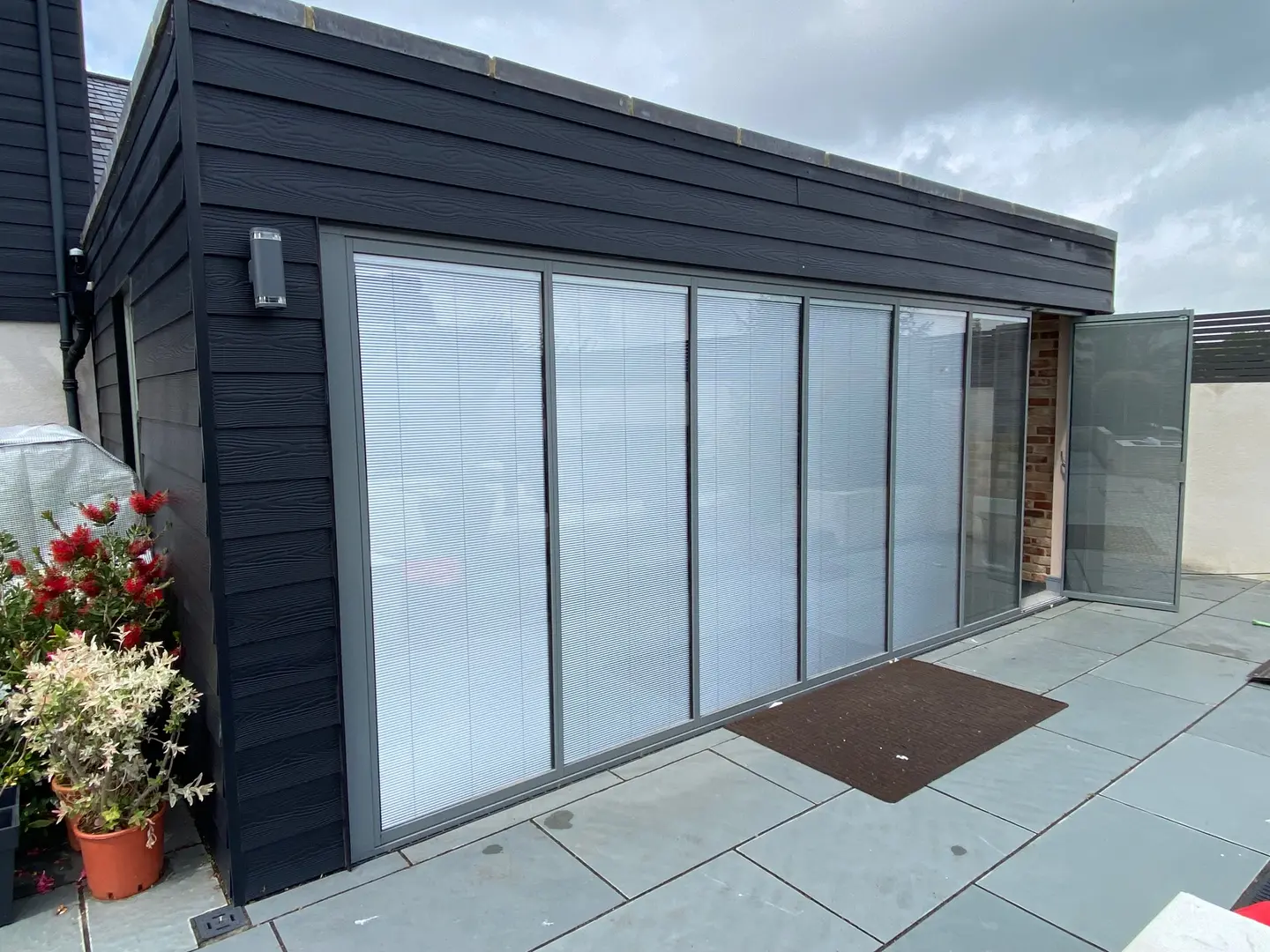
Additional Glass Elements
Side panels multiply the benefits of garden office doors by extending views and light penetration deeper into the workspace. Fixed glazing beside operating doors creates panoramic effects without compromising security or thermal performance. These supplementary panels prove particularly valuable in morning or evening light when the sun sits lower on the horizon.
Transom windows above sliding patio doors add extra dimension to your office lighting. These high-level panels capture light even when blinds cover the main doors, useful during screen-heavy work sessions. They also provide ventilation options without fully opening the main door sections.
Garden office ideas often incorporate corner glazing to open up multiple views. This arrangement helps track the sun’s movement throughout the day while creating interesting shadow patterns across work surfaces. Corner installations need precise planning to maintain structural integrity, but the results can revolutionise how you experience your workspace.
Managing Brightness
Double glazed bifold doors often benefit from integrated blind systems that help control light levels. Pleated blinds tucked between glass panes stay dust-free while providing quick adjustment options. External shading might offer better heat control, but internal systems generally prove more practical for day-to-day use.
Different glass specifications help manage varying light conditions around your office. South-facing garden office doors might need solar control coatings to prevent overheating, while north-facing installations could prioritise high light transmission. The glass choice affects not just brightness but also colour rendering – important when your work involves design or colour matching.
Carefully positioned partial frosting creates privacy without blocking natural light. Lower sections can obscure desk height views while keeping sight lines clear above, particularly useful in overlooked gardens. Gradual fade patterns offer another option, becoming progressively more opaque towards the bottom of the glass.
Light Distribution Techniques
Reflective surfaces near garden office doors help bounce natural light deeper into the workspace. Pale ceilings and walls multiply the effectiveness of your glazing, while glossy desk surfaces can create unwanted glare. The interaction between artificial and natural light needs special attention in video call setups, where balanced illumination improves camera performance.
Light shelves – horizontal elements above eye level – can improve illumination towards the back of deeper offices. These architectural features redirect incoming sunlight upwards, helping it reach further into the space. When integrated with the door frame design, they appear as natural parts of the overall composition rather than obvious additions.
The position and orientation of internal partitions or storage units relative to your doors influences overall light distribution. Perpendicular walls can create darker corners, while angled surfaces help guide natural light throughout the space. Glass partition elements maintain light flow while providing acoustic separation when needed.
Climate Control Through Garden Office Doors
Temperature regulation in garden offices needs careful planning throughout the year. Modern glass door systems offer multiple ways to maintain comfortable working conditions while managing energy costs.
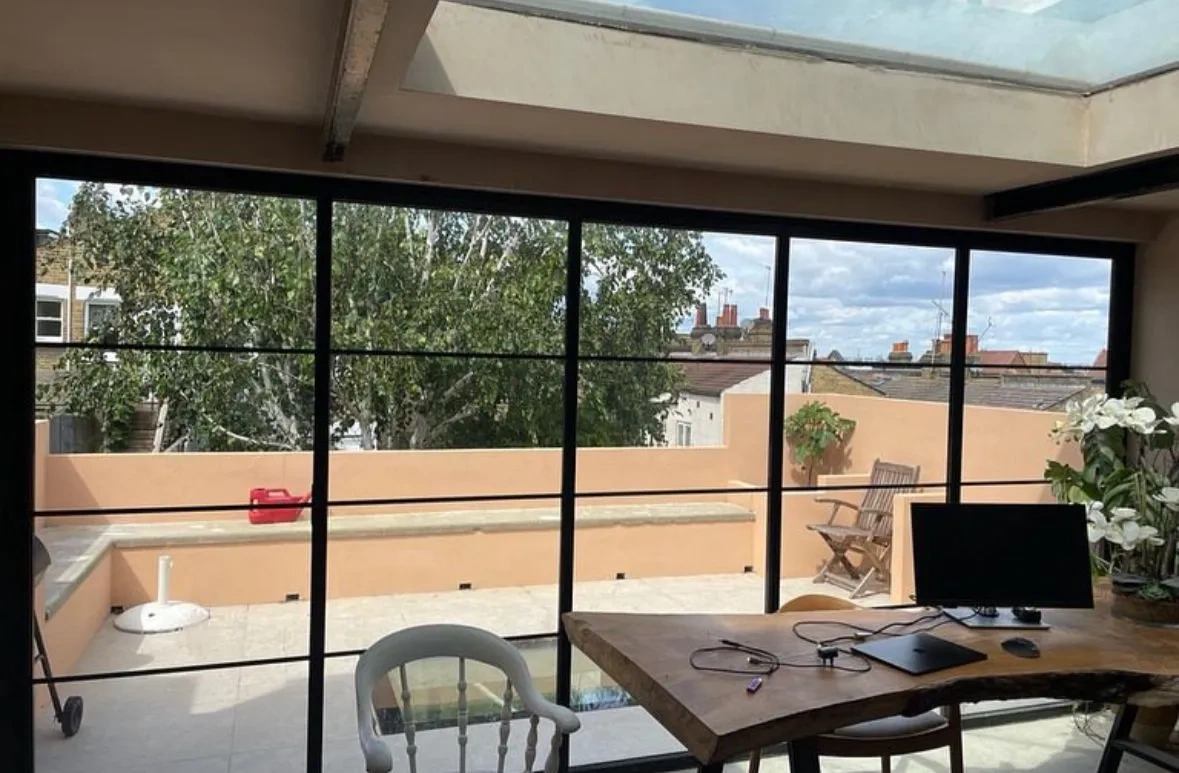
Year-Round Temperature Management
Garden office doors with advanced thermal breaks prevent cold spots near glazed areas during winter months. These insulating barriers, built into the frame structure, stop heat escaping through the metal components.
The right combination of glass and frame insulation can cut heating costs substantially during colder seasons.
Multiple glass layers in garden room sliding doors trap air or inert gases between them, reducing heat transfer in any weather.
The space between panes acts as an insulator, while special coatings reflect heat back into your office in winter. During summer, these same coatings help deflect unwanted solar gain.
Garden office glass doors need to handle rapid temperature changes without compromising their operation. Expansion gaps built into the frame allow materials to move naturally as temperatures fluctuate. This subtle engineering prevents sticking or binding that might otherwise occur during weather shifts.
Thermal Performance Testing
Quality garden office doors undergo rigorous testing to measure their insulation properties. U-values indicate how well the entire door system restricts heat flow, while solar gain coefficients show how effectively it manages sunlight. These measurements help predict energy usage and comfort levels throughout the year.
Ventilation Strategies
Fresh air circulation keeps you alert and productive during long work sessions. Garden office doors with built-in trickle vents provide background airflow without compromising security. These small openings, often integrated into the frame, help prevent stuffiness even when the main panels stay closed.
Properly positioned opening sections create effective cross-ventilation patterns. Air moves naturally through the space when you open panels on opposite sides, helping maintain comfortable conditions without relying on mechanical systems. This natural airflow proves particularly valuable during video calls or client meetings where background fan noise might disturb communication.
Multi-panel configurations let you fine-tune ventilation levels according to weather conditions and occupancy. Partial opening options help manage air movement while keeping rain out during changeable weather. Smart placement of operating panels near work areas gives you quick access to fresh air when needed.
Managing Heat Gain
Solar control glazing in garden office doors reduces overheating without darkening your workspace excessively. These specialised glass units filter out infrared radiation while letting visible light through, helping maintain natural illumination levels. The coating technology has improved markedly in recent years, offering better performance without the strong tinting often seen in older installations.
External shading systems provide extra protection against summer heat. Retractable awnings or pergolas can shade your glass doors during the hottest parts of the day while retracting to allow beneficial heat gain in winter. Fixed overhangs need careful sizing to block high summer sun while admitting lower winter light.
Internal temperature patterns change as the sun moves across your office. Morning sun through east-facing doors might feel pleasant, but western glazing often leads to afternoon overheating. Monitoring how different areas warm up helps you arrange your workspace more effectively, potentially moving heat-sensitive equipment away from direct sunlight.
Heat management through glass takes on extra importance when electronic equipment fills your office. Computers and other devices generate their own heat, which adds to solar gain through glazing. Strategic placement of equipment relative to your doors helps prevent hot spots from developing near workstations.
Security for Garden Workspaces
Garden office doors require robust security features to protect valuable equipment and sensitive materials. Modern locking systems combine physical strength with sophisticated mechanisms to deter unauthorised access.
Locking Systems
Multi-point locks secure garden office doors at several points along the frame, making forced entry extremely difficult. Each locking point engages with reinforced keeps, spreading the load across the entire door structure rather than concentrating it at a single point. This distributed locking pattern proves particularly important in wider door sets where traditional single-point locks might allow flex in the panels.
Garden office glass doors often incorporate anti-lift devices that prevent panels from being removed from their tracks. These mechanisms, hidden within the frame, activate automatically when the door locks. Deadbolts extending into the frame head add extra protection, while still allowing smooth operation during normal use.
High-security cylinders in garden office doors resist common attack methods like picking or drilling. Key-controlled systems let you manage access rights precisely – useful when contractors need temporary entry to maintain equipment. Some advanced systems integrate with smart home networks, sending alerts to your phone if doors are left unlocked.
Security Glazing Standards
Laminated glass panels resist break-in attempts while protecting against accidental damage. The internal plastic layer holds broken glass together, maintaining a barrier even if the glass cracks. This construction method also improves sound insulation, helping keep sensitive business conversations private.
Privacy
Garden office doors need to balance security with natural light and views. Remote-controlled blinds tucked between glass panes offer instant privacy without compromising the clean lines of your workspace. These systems stay dust-free and protected from damage while providing quick visual security during client meetings or video calls.
Strategic positioning of storage units and screens near glass panels creates privacy zones without blocking all natural light. This arrangement lets you maintain sight lines to the garden while keeping sensitive materials out of view from outside. Careful space planning helps manage visibility without resorting to permanent screens or frosting.
Practical Safety Measures
Sensor-activated lighting around garden office doors improves security while helping you navigate safely after dark. Motion detectors can trigger lights both inside and outside your office, deterring opportunistic intruders while making early morning or evening access more comfortable.
CCTV cameras overlooking door areas provide valuable evidence if incidents occur. Modern systems offer high-definition recording and remote viewing through smartphone apps, letting you check your office security from anywhere. Visible cameras often prevent attempted break-ins, making them worth thinking about even in low-risk areas.
Physical barriers like planters or bollards near garden office doors prevent ram-raid attempts without creating an unwelcoming appearance. These obstacles can form part of your garden design while providing practical protection for your workspace. Native planting in security features helps them blend naturally with the surrounding landscape.
Window film adds an extra layer of security to glass panels without changing their appearance. These barely visible layers make glass harder to break and help hold shattered pieces together. Some films also reduce UV transmission, protecting equipment and furniture from sun damage while maintaining clear views.
We’d Love to Help You
Vision Glass Doors is a designer, manufacturer, and installer of premium door systems. We are a family run business with over 20 years’ experience and 5,000 installations across the UK.
Our leading range of door systems include Ultra Slim – Slide and Turn Doors, Slimline Sliding Patio Doors and Frameless Glass Doors. Suitable for various internal and external applications, they are applicable to residential and commercial projects.
Click Quick Quote Online for a free quotation within 24 hours. Alternatively, call or email us on 01582 492730 or at info@visionglassdoors.co.uk.

